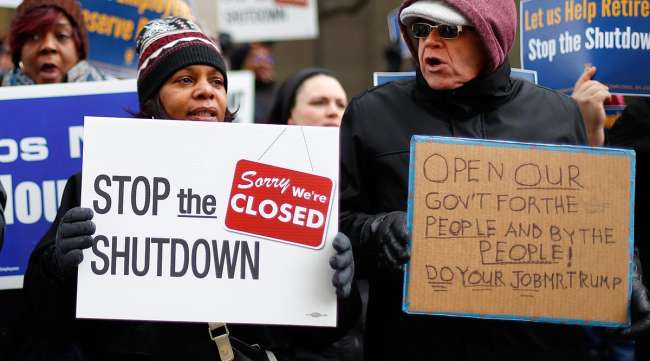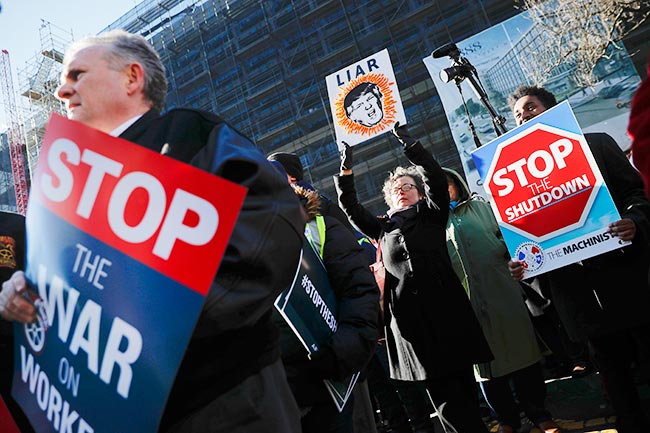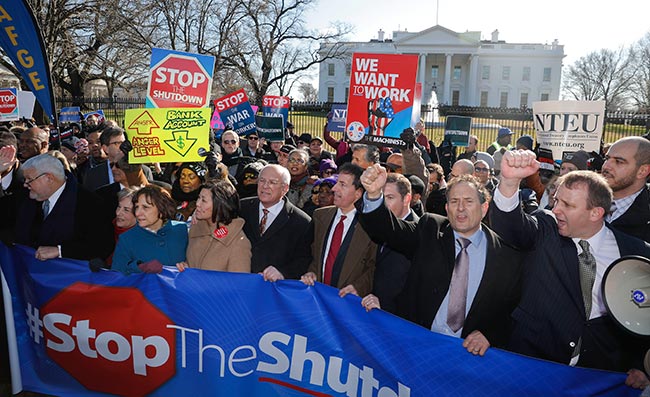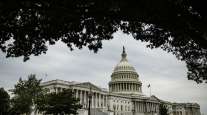How a Prolonged Government Shutdown Might Ripple Down to States

Almost a third of the $2 trillion that U.S. states spend each year comes from Washington, so the partial shutdown of the federal government would seem to spell major financial trouble in America’s statehouses. So far, the impact has been relatively limited, because only about a quarter of the government has been closed and funding for the biggest state-run program, Medicaid, will continue no matter how long the impasse persists.
While the president has said he’d be willing to keep some of the government shut for months if lawmakers don’t agree to fund a wall on the Mexican border, he may seek to circumvent Congress in a bid to end the standoff. But if the closure persists, the impact on states may grow, particularly in those with a large number of federal employees.
Missing Paychecks
As some 800,000 employees begin missing paychecks, the impact will ripple through economies with a big share of federal workers, including Virginia, Maryland, Hawaii and Alaska, where about 5% of workers are employed by the federal government, according to Fitch Ratings. Virginia Gov. Ralph Northam, a Democrat whose state has some 130,000 federal employees, said the 2013 shutdown cost residents in the area around the capital $217 million a day in wages — a hit that was minimized because Congress decided to pay them back.

Pablo Martinez Monsivais/Associated Press
The lost pay, however, will be felt far beyond the beltway in places like Florence, Colo., a 3,800-person city home to a federal prison complex where more than 860 people are working without compensation. Nationwide, Moody’s Analytics estimates the shutdown will slow economic growth by about 0.04 percentage points for every week that it lasts, which would crimp sales-tax collections for states and cities.
Saving Safety Net
The longer it drags on, the more states would be forced to tap their own funds to make up for numerous programs supported by federal grants, including Temporary Assistance for Needy Families, which extends cash payments to the poor. The shutdown has cut off funding for that program, among others, according to the Center for Law and Social Policy. That’s left states relying on federal money from prior year budgets, but they’d need to step in once that runs out, said John Hicks, executive director of the National Association of State Budget Officers. “There is no default as to what the response would be by states,” he said.
Renters at Risk
While vouchers for poor renters are expected to continue through February, about 1,150 Housing and Urban Development Department contracts with local housing projects that were up for renewal were put on hold this month, affecting 70,000 to 85,000 low-income households, according to the Campaign for Housing and Community Development Funding.
Over a thousand more come up for renewal through the end of February, and some of the developers count on the money to repay municipal bonds that financed the projects. “You’re put in a pretty sticky situation where you have to make debt service but you don’t have a significant part of the project income — so at some point, you might have to opt out and re-tenant the building with people that can pay the rent,” said Thom Amdur, executive director of the National Housing and Rehabilitation Association. “There are millions of low-income families living in subsidized housing that are put at risk as a result of this.”
Bond Market Spillover
A standoff that lasts past the end of the debt-ceiling suspension on March 1 could increase the risk of a technical default on the U.S. debt and raise the likelihood of a downgrade, according to some ratings analysts. A downgrade to the Treasury’s rating would likely trigger municipal-bond rating cuts, which happened in 2011, when S&P Global Ratings cut the grades on thousands of state and local securities tied to the federal government.

Pablo Martinez Monsivais/Associated Press
Separately, Moody’s Investors Service said the impact of the shutdown has been minimal on municipal-bond issuers so far. If it goes longer, it could cut into tax revenue in areas that are reliant on federal workers, making it more of a challenge for governments, Moody’s said.
Subways, Trains, Roads
Public subways, commuter trains and other transit systems rely heavily on federal grants that would be slowed if employees remain idled. Such funding can account for a fifth of some operating budgets, according to Moody’s, which warned that a disruption could lead to weaker financial positions, delayed projects and higher debt costs. Problem-plagued New Jersey Transit Corp.’s available cash, as of 2017, was only enough to cover about one month’s operations, the rating company said.
The uncertainty about the budget may also slow the pace of work on infrastructure projects because states can’t say for sure how much they will get once the budget impasse ends. “States are not going to be letting new projects because of the uncertainty associated with the federal program,” said Jim Tymon, executive director of the American Association of State Highway and Transportation Officials. One state already has done that: Oklahoma officials said they’re delaying new contracts for about 45 upcoming projects totaling more than $137 million because of the shutdown.




